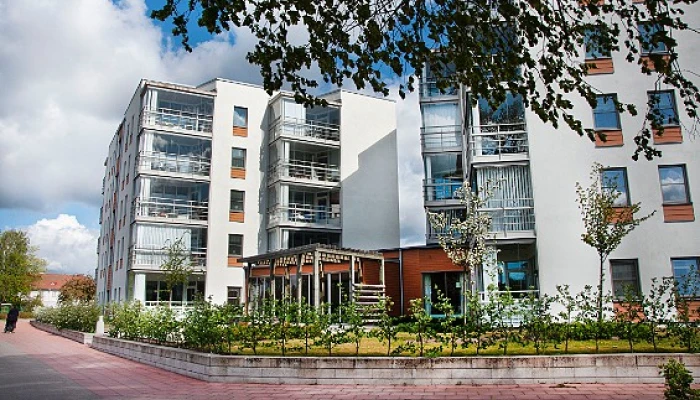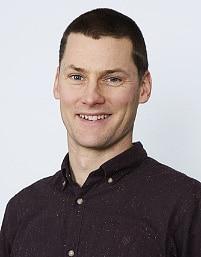Regarding digitization and implementation of technical property systems, Tibrobyggen, a public housing company in Tibro, has carried out a significant project where they connected their existing overall system (SCADA) with our AI service, Edge.
Tibrobyggen
In Tibro, Jesper Sjöholm works as a technical and energy engineer responsible for the project to connect their different platforms.
Tibrobyggen has a strong vision of how they want their building technology system to work. At the start of the project, they were clear about the objectives of promoting integration and collaboration rather than replacement and purchase.
What made you decide to start this project?
Tibrobyggen's digitalization journey began in January 2022, and they started from scratch. Step 1 was to install indoor sensors in all apartments to keep track of indoor temperatures to ensure the tenants' comfort. Since then, digitalization and investment in technical property systems have continued.
– We wanted to start at the right end, which is always our tenants, so we prioritized finding ways to ensure the comfort of our tenants. Once that was in place, we started looking at the overall system (SCADA) to get control and monitoring of the technical operations, and we chose Arrigo as the platform for this. This is where the first integration began, as we integrated the indoor sensors inside the apartments with Arrigo. Then, we could gather information about the apartments' indoor climate in one place, Jesper says.
– As a next step, we wanted to look at some sort of smarter control with AI to optimize the indoor climate for our tenants further and save energy use. In addition, we wanted it to integrate with our SCADA. Edge AI could easily be traded via HBV and was also completely open and integrable via API, so we contacted our integration partner SI, and started the work.
Edge AI could easily be traded via HBV and was also completely open and integrable via API, so we contacted our integration partner SI, and started the work.
An ecosystem of building technology systems formed around Tibrobyggen
– These property management systems and platforms give us visibility and control while providing us with dynamic operational pictures, system alerts, in-depth analysis, and reports. By combining these technologies, we can create a cohesive, intelligent end-to-end solution beyond energy efficiency - providing our tenants the best possible living conditions while meeting our sustainability goals, Jesper explains.
Injecting AI from Edge
– The integration of Edge AI to the Arrigo SCADA platform has changed a lot for us. Above all, smarter and more precise control results in a more even indoor climate by cutting highs and lows in the indoor temperature. This means better comfort for our tenants regardless of external factors such as changing weather.
– In this project, the primary goal has not been to save energy; it is instead a bonus, but our approach is, of course, to work for as little energy use as possible and at the same time balance it with providing the most essential thing of all – good comfort for our tenants. But in days of sharply increased district heating costs, Edge AI brings a great tool to manage these costs quickly and efficiently. Integrating the function entirely digitally, without on-site installations, is an appealing future-proof solution for me, he continues.

Open, flexible, and independent
– In terms of technology, our overall objective in this project has been to create an ecosystem of platforms and services that give us control of the technical installations in our properties, the possibility of remote monitoring and customization to achieve an efficient and digital way of working internally. We are a small company with 15 employees, so it is of utmost importance for us to be efficient in our processes and how we work. It is also crucial for us that it is future-proof, so if someone leaves and another comes in, the technical property systems must be set up to support the way of working regardless of who performs the job.
– Therefore, it was essential to use the systems we already have and integrate them rather than replacing and buying something new. We discussed this requirement with Kiona and our integration partner SI, which was received very positively.
Bjarne Johansson, Technical Manager at SI, agrees that the discussions within the project have been positive from the start.
Systeminstallation i Varberg AB (SI)

– We are very pleased to contribute to a successful project; this is a good example of integration between platforms to give the customer greater value. We at SI deliver services across a number of platforms, and in this case, Arrigo and Kiona's solutions are used to achieve results, says Bjarne Johansson.
– I was pleasantly surprised by the positive attitude of all parties involved towards integrating and connecting existing systems. There were no problems anywhere but rather a driving force in the project to fully embrace the power of openness. It feels like the importance of "openness in systems" that is talked about in the industry is becoming increasingly real, says Jesper Sjöholm.
– For us at Kiona, open, flexible, and independent systems are one of the cornerstones of our entire product strategy. In addition to integrating with our own SCADA platform Web Port, we are more than happy to integrate with Arrigo, Citect, and other SCADA platforms out there. Currently, the final phase of integrations to even more platforms is underway. It feels really good that it is appreciated so much by partners, end customers, and industry colleagues, says Mattias Holm, who has been responsible for the project at Kiona.
In addition to integrating with our own SCADA platform Web Port, we are more than happy to integrate with Arrigo, Citect, and other SCADA platforms out there. It feels really good that it is appreciated so much by partners, end customers, and industry colleagues.
Finally, Jesper, do you notice any difference in how it is to implement this type of project today compared to 5-10 years ago?
– There is a big difference today; a lot has happened in the last ten years! If we take AI as an example, it is talked about everywhere. It was something new and untested in the past, but today, it is an off-the-shelf product that is a standard in many municipalities.
– Another thing is the use of open systems. It is incredibly important today, compared to the past when you might have bought a packaged solution from a supplier. Today, there are entirely different requirements to integrate and pick puzzle pieces from other suppliers into a more customized solution that is shaped according to our needs and wishes. Open systems mean more opportunities and can be more complex because you need to keep track of more pieces of the puzzle, so finding a strategy adapted to our specific needs is essential, Jesper concludes.
